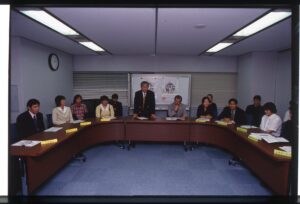“History of the Nadeshiko League”9. “Withstanding the Winter Years”
From the time when it was still unusual for women to play football, through to the birth of the Japan Women’s Football League, victory in the Women’s World Cup, and creation of the Japan Women’s Empowerment Professional Football League, social conditions and the environment surrounding girls’ and women’s football have undergone great changes.
We intend to publish a series of 22 articles before the end of the year in which we will look back over the tempestuous history of girls’ and women’s football in Japan.

Nikko Securities Dream Ladies rejoiced at winning the L. League (the current Nadeshiko League) for the third consecutive year in 1998, however, for many people it was a bittersweet moment. That was because it had been decided to disband the team at the end of the season.
Sport is not unrelated to events in the world. Indeed, it may even be said that sport reflects the world’s developments as they are.
Surely everybody has heard about the “collapse of the bubble economy”. Between the mid-1980s and 1991, Japan’s economy expanded at a rapid rate. However, rather than being supported by solid economic growth, the expansion was driven by rapid inflation in land prices, which gave land-owning companies the mistaken belief that they possessed great wealth. Once this cycle was interrupted, the economy burst like a “bubble”.
The Japanese economy started to show signs of recovery following the shock of the bubble collapse, however, it slumped again in 1998. As a result, many companies resorted to “restructuring”, which entailed cutting employees and so on. When companies are faced with the need to cut expenses by even a single yen, they cannot justify spending hundreds of millions of yen on sport every year. Accordingly, many companies cancelled their backing for sports, leading to the dissolution of teams and downsizing of activities.
It is said that almost 150 corporate sports teams in all disciplines were dissolved in the decade following the collapse of the bubble economy. This brought an end to the period of sporting domination by corporate teams in Japan, which had continued from the Showa era.
Naturally, these effects extended to football too. In October 1998, an event that overshadowed news of the “dissolution of Nikko Securities” sent shockwaves through the football world. It was announced that Yokohama Flugels of the J. League was to be merged into the Yokohama Marinos. This similarly came about due to the poor business performance of the two clubs’ sponsors, namely All Nippon Airways and Nissan Motor Corporation.
In the L. League, around the same time as the dissolution of Nikko Securities, it was decided to disband Fujita Soccer Club Mercury, while Suzuyo Shimizu FC Lovely Ladies and Shiroki FC Serena announced their withdrawal from the league in 1999. The 1999 league was scheduled to kick off in July following the end of the FIFA Women’s World Cup in June, and the addition of Urawa Reinas FC (the current Mitsubishi Heavy Industries Urawa Reds Ladies) and Nippon Sport Science University LSC brought the number of competing teams up to eight. However, by the end of the year, Nippon Sport Science University LSC and “OKI FC Winds” had announced their withdrawal.
Women’s football in Japan had been banking on the FIFA Women’s World Cup held in the United States in June 1999 to rejuvenate popularity. Since teams reaching the quarter finals of the World Cup were granted the right to participate in the Olympic Games to be held in Sydney the following year, the aim was to enhance recognition of women’s football by qualifying for the Olympics. However, although Japan drew its first game with Canada 1-1, it lost its next two games to Russia and Norway 0-5 and 0-4 respectively and finished fourth in its group. Having thus lost the chance to appeal its presence on the Olympic stage, women’s football in Japan was faced with a major crisis that went beyond the L. League.
Prior to the start of the next league season in July 2000, the two companies of Prima Ham and Matsushita Panasonic, which had supported teams in the league, decided to withdraw their backing. However, the teams themselves decided to stay in the league, becoming “citizens’ teams” renamed as “Iga Football Club Kunoichi” and “Speranza FC Takatsuki” respectively.
The L. League also made a major decision. League membership had increased to nine teams with the addition of three newcomers, namely “YKK Tohoku Ladies SC Flappers” (Miyagi Prefecture), “JEF UNITED ICHIHARA LADIES” and “Renaissance Football Club” (Kumamoto Prefecture), however, it was decided to first divide the league into East and West, and then into a league for the upper-placed teams and a league for the lower-placed teams. Of course, this was done to save on teams’ travel expenses for away games. At the same time, whereas games before then had been held in “stadia” with seating for spectators, it became possible to hold games on practice grounds without charging any admission.
Meanwhile, changes were made to the basic policy of deciding which teams should be promoted to the league. Whereas, previously, teams that wished to join the league played against each other to determine which should be promoted, a “pyramid” was established whereby the L. League was placed above prefectural leagues and area leagues. In this way, the L. League became the pinnacle of women’s football in Japan overall.
In the midst of its “winter years”, the L. League devoted all its energy to survival at all costs based on a determination to “not extinguish the light for the future of women’s football in Japan”.
Yoshiyuki Osumi (football journalist)






